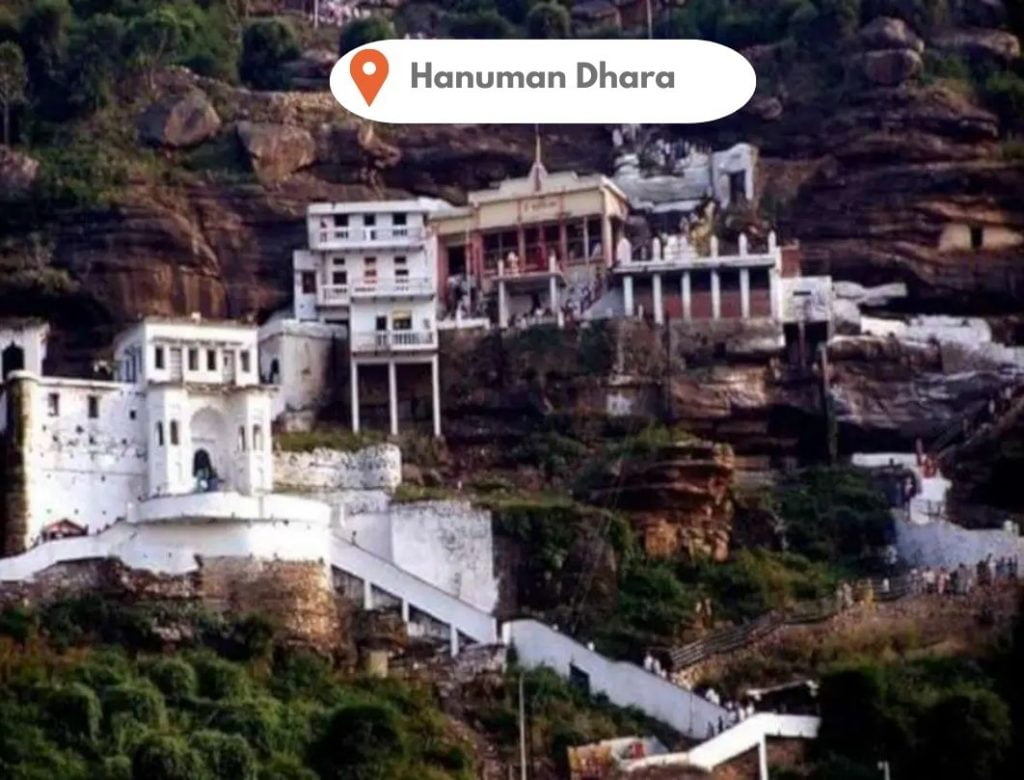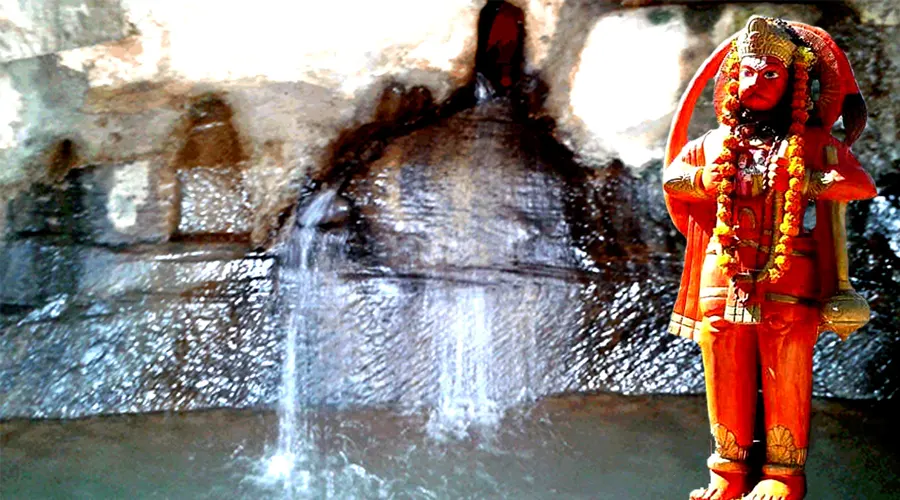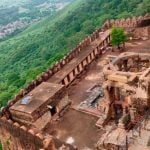Nestled on the serene hills of Chitrakoot, Hanuman Dhara stands as one of the most spiritually uplifting and visually captivating spots in the region. More than just a natural wonder, this sacred waterfall is deeply intertwined with the legends of the Ramayana, offering pilgrims a place where faith meets the flow of nature.
Rising over 500 steps into the Vindhya ranges, Hanuman Dhara is not merely a destination—it’s a devotional journey, both physical and spiritual, leading to a place where Lord Hanuman himself found peace and liberation. In this article, we delve into the mythological importance, spiritual experience, and cultural relevance of this revered site.

Mythological Origins: Hanuman’s Return from Lanka
According to Valmiki Ramayana, when Lord Hanuman returned after setting Lanka ablaze during the search for Sita, his body was still burning from the fire. It is believed that upon reaching Chitrakoot, Lord Rama directed Hanuman to this hill, where a stream of cooling water sprang from a rock to soothe and relieve his burning body.
Symbolism:
- The waterfall symbolizes divine healing and grace
- It marks Hanuman’s transition from warrior fury to humble devotion
- Represents the purification of body, soul, and karma
This sacred spot thus became Hanuman Dhara—”Dhara” meaning stream or flow—eternally associated with spiritual cleansing and inner peace.
Spiritual Journey: Climbing to Hanuman Dhara
Pilgrims ascend around 550 steep steps carved into the hills to reach the shrine and waterfall. The climb itself is considered a test of devotion, as it requires both physical effort and mental determination.
Key Highlights of the Ascent:
- Panoramic views of the Mandakini River and Chitrakoot valley
- Monkeys often seen as guardians of Hanuman’s abode
- Spiritual chants echoing in the background from devotees
Each step is seen as a step toward inner purification, with many pilgrims reciting Hanuman Chalisa during the climb.
The Hanuman Temple at the Summit
At the top rests the Hanuman Dhara Temple, housing a majestic idol of Lord Hanuman in a seated, meditative posture. Unlike his usual fierce form, here Hanuman is shown calm and composed, reflecting the serenity he attained after fulfilling his mission.
Temple Features:
- A continuous stream of holy water drips onto the idol’s head
- Priests perform rituals and aartis daily
- Pilgrims often sit for hours in silence, absorbing the spiritual energy
The holy water, believed to emerge from a natural spring within the rock, never dries—even in peak summer—and is considered to have miraculous healing properties.
Natural Beauty and Divine Silence
Beyond the myth and the temple, Hanuman Dhara offers an aura of profound tranquility. The sound of the water trickling down, the rustling leaves, and the chants from the shrine together create an atmosphere that feels otherworldly.
Nature’s Role in Devotion:
- Birds chirping in the canopy above
- Cool breeze flowing through Vindhya hills
- Ideal place for meditation and self-reflection
This rare fusion of natural elements with spiritual essence makes Hanuman Dhara a place not just of pilgrimage but transcendence.
Other Attractions Nearby
While Hanuman Dhara is a major spiritual magnet, the surrounding area also houses important sites worth visiting:
Sita Rasoi
A symbolic kitchen cave where Goddess Sita is believed to have cooked meals for Rama and Lakshman during their exile.
Ram Ghat
Located at the base of the hill, it is a sacred bathing spot on the banks of the Mandakini River, where saints gather for daily rituals and discourse.
Gupt Godavari Caves
A short drive from Hanuman Dhara, these mysterious caves are believed to be the secret court of Lord Rama and Lakshman, featuring an underground river and divine rock formations.
Rituals & Practices at Hanuman Dhara
Common Devotional Acts:
- Abhishek (ritual bathing) of Lord Hanuman with sacred water
- Lighting of ghee lamps and incense sticks
- Recitation of Sundarkand and Hanuman Chalisa
- Offering coconuts, red cloth, and sindoor (vermillion)
Pilgrims often collect a bottle of Hanuman Dhara’s water to carry home, believing it brings protection, strength, and blessings.
Best Time to Visit Hanuman Dhara
The waterfall and shrine are open year-round, but the ideal time to visit is during:
- October to March: Pleasant weather and clear views
- Hanuman Jayanti: Celebrated with grandeur and special rituals
- Diwali & Ram Navami: Vibrant and spiritually charged atmosphere
Avoid the monsoon season (July-August) due to slippery stairs and heavy rainfall.
Travel Tips for Pilgrims
- Footwear is not allowed beyond a certain point—wear easy-to-remove sandals
- Carry water and light snacks, especially if climbing with elderly family members
- Early morning or late afternoon is the best time to avoid the sun during the climb
- Local guides are available and can share mythological stories and symbolism
Cultural Significance & Legacy
Hanuman Dhara isn’t just a religious site—it’s a symbol of transformation. The fire-touched Hanuman, soothed by a divine stream, reminds us that:
- Rage can be turned into surrender
- Power must be tempered with peace
- Devotion ultimately purifies and uplifts the soul
For generations, saints, sages, and everyday devotees have made their way to Hanuman Dhara—not merely to see, but to experience a moment of stillness, power, and divine grace.
Conclusion: Where Nature Meets the Divine
Hanuman Dhara is where myth becomes real, where the echoes of the Ramayana still ring through the hills, and where a gentle stream continues to bless those who come with open hearts. It stands as a living reminder that healing, peace, and transformation are always within reach when approached with faith.
For any seeker visiting Chitrakoot, this sacred waterfall is not to be missed—it offers more than sight; it offers soulful connection.





